How car electrical systems work
The Video Course teaches you everything about modern cars.
The electrical system of a car is a closed circuit with an independent power source the battery . It operates on a small fraction of the power of a household circuit.
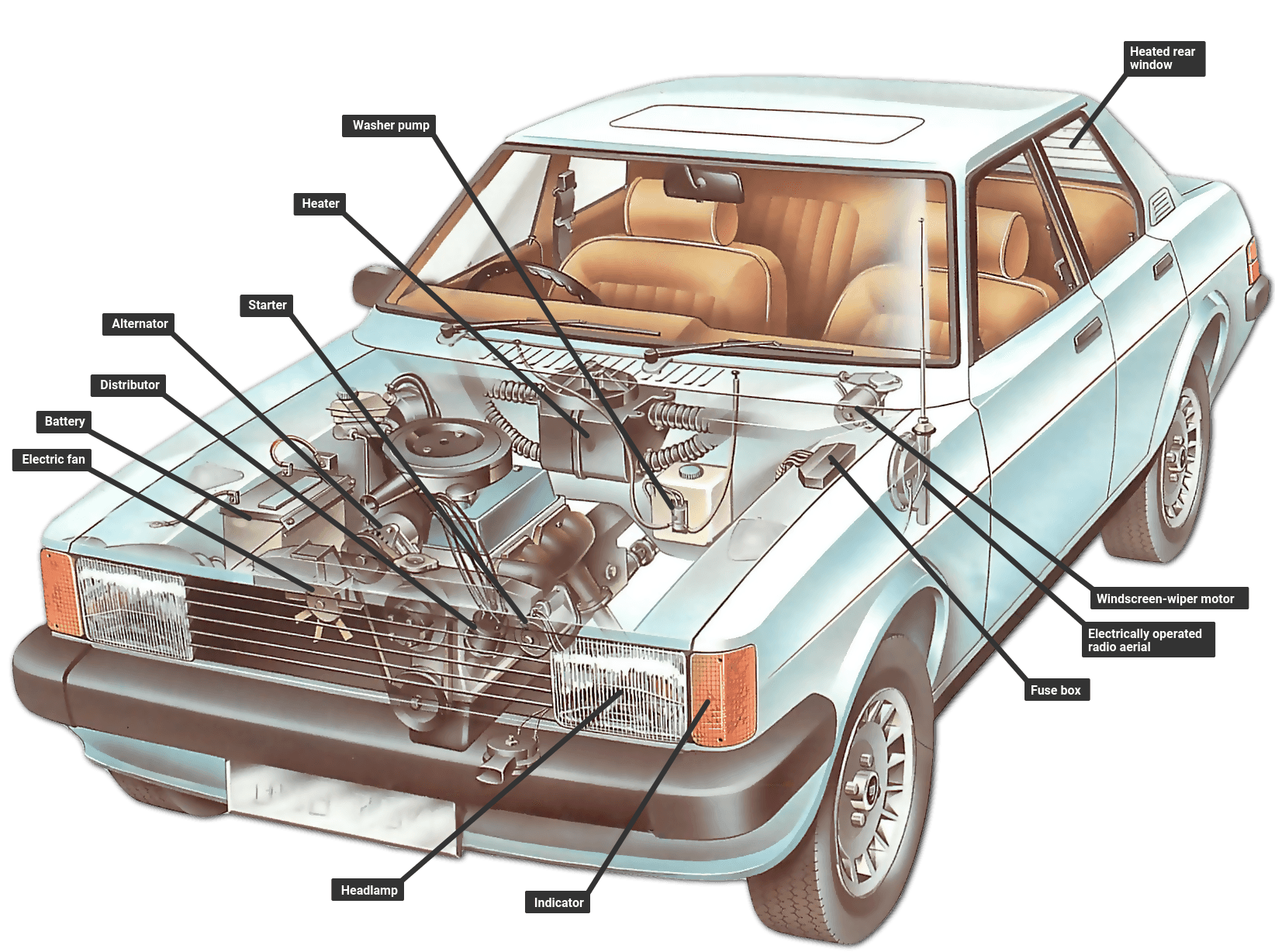
Current flows along a single cable from the battery to the component being powered, and back to the battery through the car's metal body. The body is connected to the earth terminal of the battery by a thick cable.
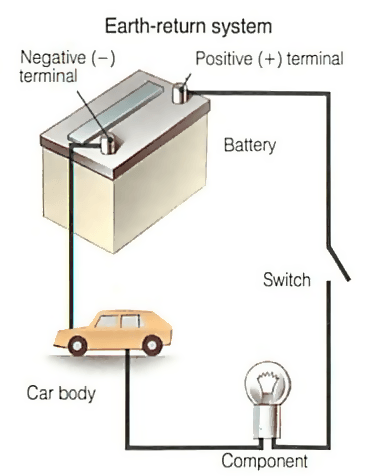
This type of circuit is called an earth-return system any part of it connected to the car body is said to be earthed.
The strength of the current is measured in amperes (amps); the pressure that drives it round the circuit is called voltage ( volts ). Modern cars have a 12 volt battery. Its capacity is measured in amp/hours. A 56 amp/hour battery should be able to deliver a current of 1 amp for 56 hours, or 2 amps for 28 hours.
If the battery voltage drops, less current flows, and eventually there is not enough to make the components work.
Current, voltage and resistance
The extent to which a wire resists the flow of current is called resistance , and is measured in ohms .
Thin wires conduct less easily than thick ones, because there is less room for the electrons to travel through.
The energy needed to push current through a resistance is transformed into heat. This can be useful, for example in the very thin filament of a light bulb, which glows white hot.
However, a component with a high current consumption must not be connected using wires which are too thin, or the wires will overheat, blow a fuse , or burn out.
All the electrical units of measurement are interrelated: a pressure of 1 volt causes a current of 1 amp to flow through a resistance of 1 ohm. Volts divided by ohms equal amps. For example, a light bulb with a resistance of 3 ohms, in a 12 volt system, consumes 4 amps.
This means it must be connected using wires thick enough to carry 4 amps comfortably.
Often the power consumption of a component will be stated in watts , which are found by multiplying amps and volts. The lamp in the example consumes 48 watts.
Positive and negative polarity
Electricity flows from a battery in one direction only, and some components work only if the flow through them is in the correct direction.
This acceptance of a one-way flow is called polarity . On most cars the negative () battery terminal is earthed and the positive (+) one feeds the electrical system.
This is called a negative earth system, and when buying an electrical accessory a radio, for example check that it is of a type suitable for your car's system. Fitting a radio with the incorrect polarity will damage the set, but most car radios have an external switch for setting the polarity to suit that of the car. Switch to the correct setting before fitting.
Short circuits and fuses
If the wrong-sized wire is used, or if a wire becomes broken or disconnected, this can cause an accidental short circuit which bypasses the resistance of the component. The current in the wire may become dangerously high and melt the wire or cause a fire.
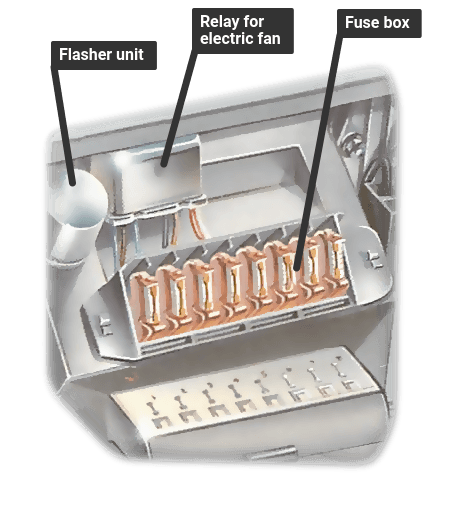
To guard against this, ancillary circuits have fuses.
The most common type of fuse is a short length of thin wire enclosed in a heatproof casing often glass.
The size of the fuse wire is the thinnest that can carry the normal current of the circuit without overheating, and it is rated in amps.
The sudden surge of high current in a short circuit makes the fuse wire melt, or 'blow', breaking the circuit.
When this happens, see if there is a short circuit or a disconnection, then install a new fuse of the correct amperage rating (See Checking and replacing fuses ).
There are many fuses, each protecting a small group of components, so that one blown fuse does not shut down the whole system. Many of the fuses are grouped together in a fuse box, but there may also be line fuses in the wiring.
Series and parallel circuits
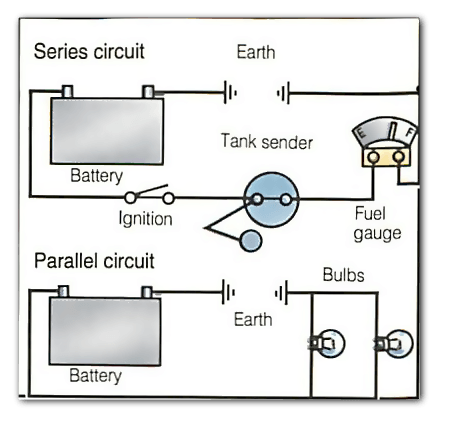
A circuit usually includes more than one component, such as bulbs in the lighting circuits. It matters whether they are connected in series one after the other or in parallel side by side.
A headlamp bulb, for example, is designed to have a degree of resistance so that it consumes a certain current to glow normally.
But there are at least two headlamps in the circuit. If they were connected in series, electric current would have to go through one headlamp to get to the other.
The current would encounter the resistance twice, and the double resistance would halve the current, so that the bulbs would glow only feebly.
Connecting the bulbs in parallel means that electricity goes through each bulb only once.
Some components must be connected in series. For example, the sender in the fuel tank varies its resistance according to the amount of fuel in the tank, and 'sends' a small electrical current to the fuel gauge.
The two components are connected in series so that the varying resistance in the sender will affect the position of the needle on the gauge.
Ancillary circuits
The starter motor has its own heavy cable, direct from the battery. The ignition circuit furnishes the high-tension impulses to the sparkplugs; and the charging system includes the generator , which recharges the battery. All the other circuits are called ancillary (subsidiary) circuits.
Most are wired through the ignition switch , so that they work only when the ignition is switched on.
This prevents you accidentally leaving something switched on which might cause the battery to go flat.
The side and tail lights, however, which you may need to leave on when the car is parked, are always wired independently of the ignition switch.
When fitting extra accessories, such as a rear window heater which consumes a heavy current, always wire it through the ignition switch.
Some ancillary components can be operated without the ignition turned on by turning the switch to the 'auxiliary' position. A radio is usually wired through this switch, so that it can be played with the engine off.
Wires and printed circuits
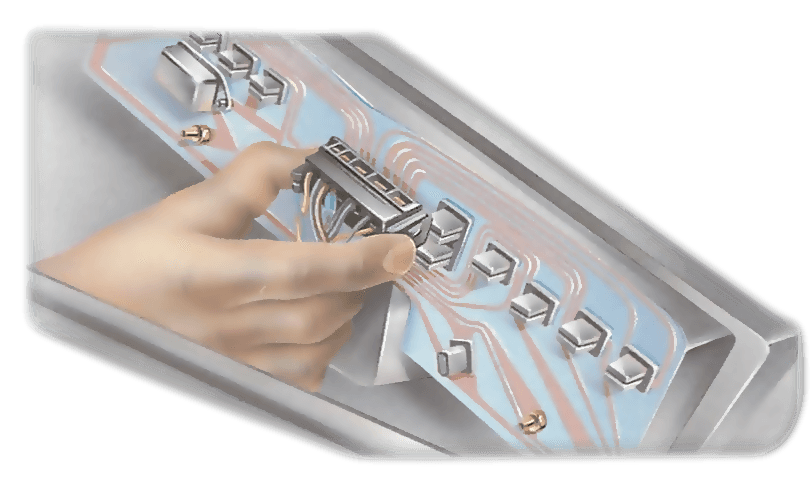
Wire and cable sizes are classified by the maximum amperage that they can carry safely.
A complex network of wires runs through the car. To avoid confusion, each wire is colour coded (but only within the car: there is no national or international system of colour-coding).
Most car handbooks and service manuals include a wiring diagram which can be difficult to follow.
The colour-coding, however, is a useful guide to tracing wiring.
Where wires run side-by-side they are bound together in a bundle, in a plastic or fabric sheath, to keep them tidy and less difficult to fit .
This bundle of wires stretches over the length of the car, with single wires or small groups of wires emerging where necessary, and is called the wiring loom.
Modern cars often need room for many wires in confined spaces. Some manufacturers now use printed circuits instead of bundles of wires, particularly at the rear of the instrument panel.
Printed circuits are plastic sheets on which copper tracks have been 'printed'. Components are plugged directly into the tracks.
The Ultimate Car Mechanics video course
Learn everything about modern cars from our new video series.
Learn more >-
We build a Mazda MX5 Miata from scratch
We start by tearing down and then rebuilding the whole car.
-
Every part explained
There's ridiculous detail on every part. Clearly and easily explained.
-
All modeled in 3D
We've created the most detailed 3D model ever produced so we can show you everything working.






